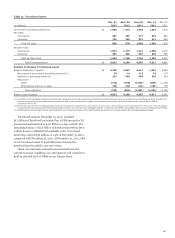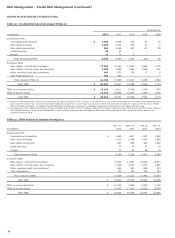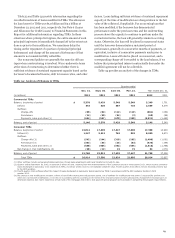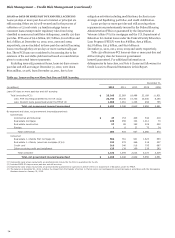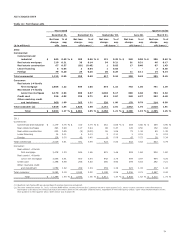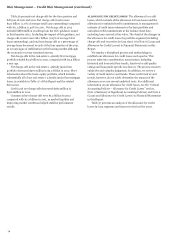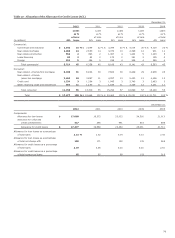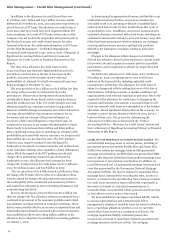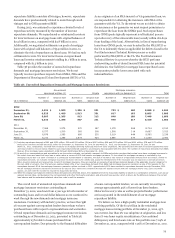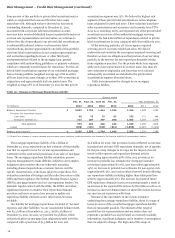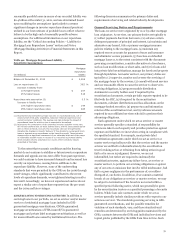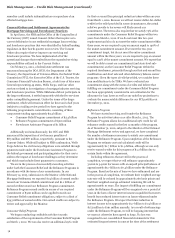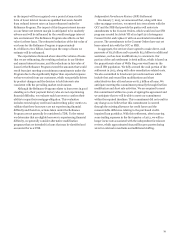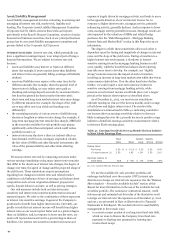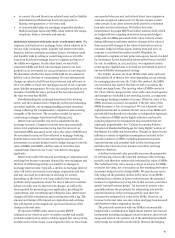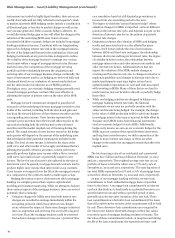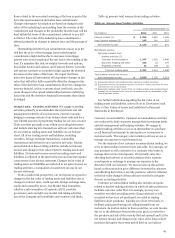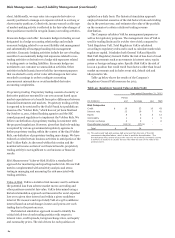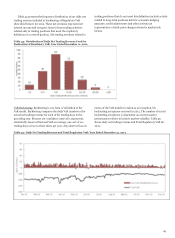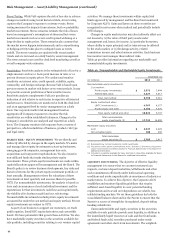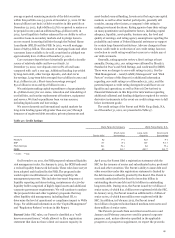Wells Fargo 2012 Annual Report Download - page 79
Download and view the complete annual report
Please find page 79 of the 2012 Wells Fargo annual report below. You can navigate through the pages in the report by either clicking on the pages listed below, or by using the keyword search tool below to find specific information within the annual report.
reasonably possible losses in excess of our recorded liability was
$2.4 billion at December 31, 2012, and was determined based
upon modifying the assumptions (particularly to assume
significant changes in investor repurchase demand practices)
utilized in our best estimate of probable loss to reflect what we
believe to be the high end of reasonably possible adverse
assumptions. For additional information on our repurchase
liability, see the “Critical Accounting Policies – Liability for
Mortgage Loan Repurchase Losses” section and Note 9
(Mortgage Banking Activities) to Financial Statements in this
Report.
Table 40: Mortgage Repurchase Liability –
Sensitivity/Assumptions
Mortgage
repurchase
(in millions) liability
Balance at December 31, 2012 $ 2,206
Loss on repurchases (1) 39.5 %
Increase in liability from:
10% higher losses $ 207
25% higher losses 518
Repurchase rate assumption (2) 0.5 %
Increase in liability from:
10% higher repurchase rates $ 194
25% higher repurchase rates 485
(1) Represents total estimated average loss rate on repurchased loans, net of
recovery from third party originators, based on historical experience and
current economic conditions. The average loss rate includes the impact of
repurchased loans for which no loss is expected to be realized.
(2) Represents the combination of the estimated investor audit/file review rate,
the investor demand rate on those audited loans, and the unsuccessful appeal
rate on those demands. As such, the repurchase rate can be significantly
impacted by changes in investor behavior if they decide to review/audit more
loans or demand more repurchases on the loans they audit. These behavior
changes drive a significant component of our estimated high end of the range
of reasonably possible losses in excess of our recorded repurchase liability,
which includes adverse assumptions in excess of the sensitivity ranges
presented in this table.
To the extent that economic conditions and the housing
market do not continue to stabilize or future investor repurchase
demands and appeals success rates differ from past experience,
we could continue to have increased demands and increased loss
severity on repurchases, causing future additions to the
repurchase liability. However, some of the underwriting
standards that were permitted by the GSEs on the 2006 through
2008 vintages, which significantly contributed to the recent
levels of repurchase demands, were tightened starting in mid to
late 2008. Accordingly, we have not experienced and we do not
expect a similar rate of repurchase requests from the pre-2006
and the 2009 and later vintages.
RISKS RELATING TO SERVICING ACTIVITIES In addition to
servicing loans in our portfolio, we act as servicer and/or master
servicer of residential mortgage loans included in GSE-
guaranteed mortgage securitizations, GNMA-guaranteed
mortgage securitizations of FHA-insured/VA-guaranteed
mortgages and private label mortgage securitizations, as well as
for unsecuritized loans owned by institutional investors. The
following discussion summarizes the primary duties and
requirements of servicing and related industry developments.
General Servicing Duties and Requirements
The loans we service were originated by us or by other mortgage
loan originators. As servicer, our primary duties are typically to
(1) collect payments due from borrowers, (2) advance certain
delinquent payments of principal and interest, (3) maintain and
administer any hazard, title or primary mortgage insurance
policies relating to the mortgage loans, (4) maintain any
required escrow accounts for payment of taxes and insurance
and administer escrow payments, (5) foreclose on defaulted
mortgage loans or, to the extent consistent with the documents
governing a securitization, consider alternatives to foreclosure,
such as loan modifications or short sales, and (6) for loans sold
into private label securitizations, manage the foreclosed property
through liquidation. As master servicer, our primary duties are
typically to (1) supervise, monitor and oversee the servicing of
the mortgage loans by the servicer, (2) consult with each servicer
and use reasonable efforts to cause the servicer to observe its
servicing obligations, (3) prepare monthly distribution
statements to security holders and, if required by the
securitization documents, certain periodic reports required to be
filed with the SEC, (4) if required by the securitization
documents, calculate distributions and loss allocations on the
mortgage-backed securities, (5) prepare tax and information
returns of the securitization trust, and (6) advance amounts
required by non-affiliated servicers who fail to perform their
advancing obligations.
Each agreement under which we act as servicer or master
servicer generally specifies a standard of responsibility for
actions we take in such capacity and provides protection against
expenses and liabilities we incur when acting in compliance with
the specified standard. For example, most private label
securitization agreements under which we act as servicer or
master servicer typically provide that the servicer and the master
servicer are entitled to indemnification by the securitization
trust for taking action or refraining from taking action in good
faith or for errors in judgment. However, we are not
indemnified, but rather are required to indemnify the
securitization trustee, against any failure by us, as servicer or
master servicer, to perform our servicing obligations or against
any of our acts or omissions that involve wilful misfeasance, bad
faith or gross negligence in the performance of, or reckless
disregard of, our duties. In addition, if we commit a material
breach of our obligations as servicer or master servicer, we may
be subject to termination if the breach is not cured within a
specified period following notice, which can generally be given
by the securitization trustee or a specified percentage of security
holders. Whole loan sale contracts under which we act as
servicer generally include similar provisions with respect to our
actions as servicer. The standards governing servicing in GSE-
guaranteed securitizations, and the possible remedies for
violations of such standards, vary, and those standards and
remedies are determined by servicing guides maintained by the
GSEs, contracts between the GSEs and individual servicers and
topical guides published by the GSEs from time to time. Such
77


